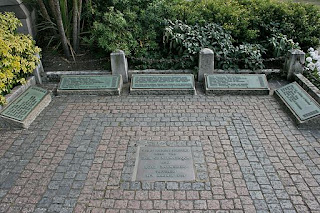Visitors to the Tower of London may not be aware that many
victims of the axe who were executed here did not die within the confines of
the walls but on Tower Hill, which is just to the north of the Tower walls, on
the other side of what is now a busy main road (but conveniently close to Tower
Hill Underground station).
Tower Hill
A small paved area marks the spot where the scaffold stood
on which non-royal victims met their end – it was “legitimate” royals, such as
Ann Boleyn and Lady Jane Grey, who were beheaded privately within the Tower
walls. The site was used between 1388 and 1747 for this purpose.
A plaque on the site reads: “To commemorate the tragic
history and in many cases the martyrdom of those who for the sake of their
faith, country or ideals staked their lives and lost. On this site more than
125 were put to death, the names of some of whom are recorded here.”
The names include those of Sir William Stanley in 1495, Sir
Thomas More in 1535, and the Duke of Monmouth in 1685.
Sir William Stanley was a noted turncoat. He had supported
the Yorkist cause during the Wars of the Roses but changed sides at the Battle
of Bosworth and, by so doing, ensured the victory of Henry Tudor who then
became King Henry VII. Henry heaped many favours on him but was astounded when
Stanley later threw his weight behind the claims of Perkin Warbeck to be one of
the “Princes in the Tower” and therefore the rightful king. Stanley was
therefore executed for treason.
Sir Thomas More lost his head because of his opposition to
King Henry VIII over the king’s desire to divorce Queen Catherine and marry Ann
Boleyn.
The Duke of Monmouth was an illegitimate son of King Charles
II who launched an abortive rebellion against his uncle King James II. Being
the child of a royal mistress rather than a wife meant that Monmouth did not
have enough royal blood to qualify for a private execution.
The last person to lose his head on Tower Hill was Lord
Lovat, who was condemned in 1747 for his part in the 1745 Jacobite rebellion. He
achieved a grim sort of revenge when a temporary stand, set up to give
spectators a better view, collapsed under the weight of around a thousand
anti-Jacobites. At least a dozen people were killed. Lord Lovat was reported to
have been amused by the incident, remarking “The more mischief, the better
sport”.
© John Welford

No comments:
Post a Comment